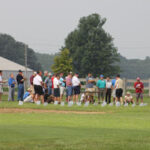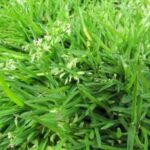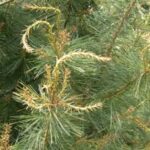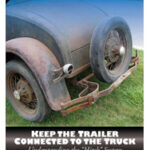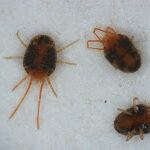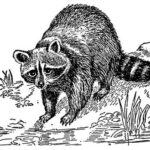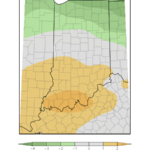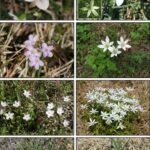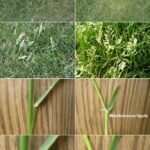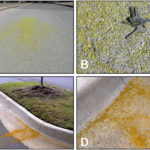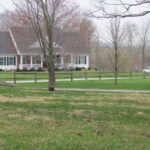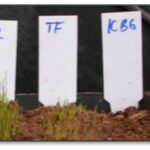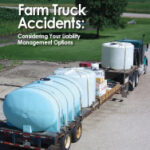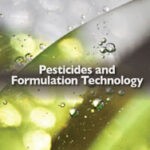Homeowner
Hot Topics at a Hot Field Day!
Thanks to all the 530 attendees and 32 exhibitors who attended the Midwest Regional Turfgrass Field Day Tuesday (July 19, 2011) at the W.H. Daniel Turfgrass Research Center in W. Lafayette, IN. We had golf and lawn research tours in the morning, two afternoon tours, and one afternoon workshop and addressed many current topics including […]
Annual bluegrass starting to succumb to summer stress in lawns
Annual bluegrass (Poa annua) is a common weed on golf courses, but is now also becoming a problem on higher mowed turf areas such as lawns and athletic fields. This grass is lighter colored than Kentucky bluegrass and perennial ryegrass and can be identified by its boat-shaped leaf tip and membranous ligule (see Turf Tip […]
Herbicide damage on Spruce and Pine – Update
A few weeks ago we posted information on herbicide damage to spruce and pine (link here). We are continuing to see some new cases of damage, but many with affected trees are simply waiting to see whether or not their trees will recover. For those of you who might have trees with suspected injury to […]
Herbicide damage on Spruce and Pine
The Plant and Pest Diagnostic Lab (PPDL) has recently received several samples of Norway spruce and white pine with symptoms that appear to be associated with injury caused by synthetic auxin (growth regulator type) herbicides. Typical off-target symptoms caused by these herbicides can include epinasty (twisting and curling) of the shoot and tips (Fig. 1) […]
Drought Damage on Zoysiagrass Lawns
Last summer and fall we experienced some widespread drought throughout the state which we documented with turf tips in July, September, and November as well as tips on reestablishment this March (click here for an archive of these tips). Most were uncertain as to what the extent of the damage would be until the turf […]
Keep the Trailer Connected to the Truck: Understanding the ‘Hitch’ System (PPP-92)
Purdue Extension Publication
This publication identifies the critical factors that keep trailers properly attached to trucks. Its goal is to help you understand how those factors work together and reduce your chances of losing a trailer on a busy highway.
Small Moving Specks on the Windowsill?
No you are not imagining this. The specks are actually moving. That is because they are actually tiny mites called clover mites. Clover mites can become annoying household pests, especially in and around homes where new lawns have recently been established or where there’s a heavy growth of well-fertilized grass close to foundation walls. They […]
Skunks and Raccoons causing Havoc?
We continue to receive reports of spring-time turfgrass damage caused by raccoons or skunks. These animals are not feeding on the grass but rather are foraging for below ground, high populations of white grubs. As the vertebrates forage, they turn over great clumps of turfgrass resulting in an area that resembles a war zone. Sometimes […]
Cooler Than Average Spring Temperatures for Some May Extend the Window for Preemergence Herbicide Applications
Preemergence herbicides prevent emergence of crabgrass plants. These products must be applied prior to crabgrass germination which on an average year could occur as early as April 1 in southern Indiana and three or more weeks later in northern Indiana. It is essential to apply these products early in spring prior to crabgrass germination. Last […]
Spring Beauty and Star-of-Bethlehem
Both spring beauty (Claytonia virginica) and star-of-bethlehem (Ornithogalum umbellatum) are spring flowering weeds that are similar in appearance and sometimes problematic in lawns. Below is a comparison of the two species including control recommendations for both turf professionals and homeowners. Spring Beauty (Claytonia virginica) Star-of-Bethlehem (Ornithogalum umbellatum) Description: Small perennial plant originating from corms. Leaves […]
To whom does this seedhead belong?
Kentucky bluegrass (Poa pratensis) is beginning to produce seedheads this time of year which are difficult to mow and can cause a lawn to appear uneven. However, there are other grasses such as annual bluegrass (Poa annua) that also produce similar looking seedheads. Annual bluegrass is a winter annual or weak perennial turfgrass species which […]
Spilled Fertilizer: Loading and Application
Fertilizer loading Fill spreaders over a hard surface such as a driveway, sidewalk, or other hard concrete or asphalt surface. This will allow easy clean-up if any material is spilled. Fertilizer spills over turf usually result in turf death to the affected spot. If product is spilled during loading (A), clean-up the material immediately by […]
What’s that brown spot: Nimblewill in lawns
Nimblewill (Muhlenbergia schreberi) is a weed that thin patches in lawns. Since nimblewill is a warm-season grass, it will turn brown at the first frost and is very slow to green-up in the spring. The brown patches seen in lawns in the early spring may be nimblewill contamination. This weed spreads from seeds produced and […]
Part III: Controlling broadleaf weeds in newly seeded areas
This turf tip is part of a three part series on spring seeding. Most turfgrass herbicides are intended for use on established grasses. Thus, herbicide use on newly planted grasses should be very conservative. If possible, wait until the grass has gone through several mowings or a full growing season before using chemical weed control. […]
Rejuvenating Turf in 2011: Part II
Part II: Preemergence and postemergence herbicides for crabgrass control in newly seeded areas This turf tip is part of a three part series on spring seeding. Early spring preemergence herbicides are often necessary in Indiana to prevent troublesome annual grassy weeds such as crabgrass and goosegrass. Additionally, these applications help to prevent the emergence of […]
New GDDTracker site is live!
The GDDTracker Team (Michigan, Indiana, Illinois, and Ohio) is proud to launch the latest version of our turf pest tracking web site (http://www.gddtracker.net/). We have been very hard at work to bring you an even better product in 2011. You can now drop a star on the map to mark your location and with the […]
Rejuvenating Turf in 2011: Part I
Part I: Spring seeding options (This turf tip is part of a three part series on spring seeding.) Seeding in spring is difficult and often unsuccessful. However, there are circumstances that warrant a spring seeding: Thin turf due to winter damage Poor turf density due to poor recovery from previous year’s problems, i.e., grub damage, […]
Pesticides and Formulation Technology (PPP-31)
Purdue Extension Publication
This publication explains the benefits and problems associated with the various pesticide formulations. It also can be used to construct a planning or decision-making model for the proper selection of a formulation in a pest control process involving pesticides.
Top Ten Turf Tips of 2010
Top Ten Turf Tips of 2010 Part II: Summer diseases in Residential Turf Part III: Summer weeds: Common summer weeds and their control Part I: Too hot: Why some turfgrass species look poor in summer Color Variation in Residential and Commercial Lawns Crabgrass Control Now is the time to seed lawns and other turf areas […]
